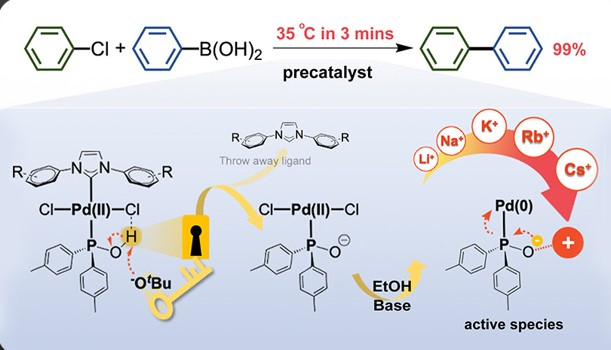Devices and processing methods for capturing and utilizing carbon dioxide
Prof. Ming-Chun Lu, Department of Environmental Engineering
本研究團隊開發的技術是在常溫常壓下,先在吸收槽中用鹼液捕集來自煙道氣中二氧化碳,再導入獨步全球的流體化床結晶槽,以均質結晶技術合成碳酸鈣均質結晶顆粒,結晶槽中的吸收液再迴流至吸收槽吸收二氧化碳,過程中因為鈣離子加入結晶塔時,已補充足夠之鹼度,所以,迴流吸收液亦可直接再吸收煙道氣排出之二氧化碳,無須再添加任何藥劑,也無須排出,因此本創新技術不會產生廢水。所產生之高品質輕質碳酸鈣結晶粒,可回收做為各種製程之添加劑本處理程序透過流體化床均質結晶技術,可在達到碳排減量的同時將資源循環利用,在淨零排放與永續發展方面皆有優秀的開發潛力。
Carbon circulation and molecular evolution in the RNA world
Prof. Yei-Chen Lai, Department of Chemistry
Our research provides insights into carbon circulation and molecular evolution within the context of the RNA world, focusing on the interplay between protocells and ribozymes. Our study demonstrates how ribozymes, when being encapsulated in protocells, significantly enhance their self-aminoacylation activity, a key step of carbon cycling and molecular evolution. We show that encapsulation offers a competitive advantage in prebiotic environments in fostering rapid evolutionary adaptation. The result underscores the importance of protocellular environments in ribozyme evolution (Results were published in Proc. Natl. Acad. Sci. USA). We also utilize the information theory to extend beyond experimental constraints in identifying and predicting catalytic RNA sequences. The developed predictive model successfully identifies high-activity ribozyme mutants, which is crucial for understanding molecular evolution pathways (Results were published in RNA). Our result sheds light on the complex mechanisms of carbon circulation and molecular evolution in the RNA world, enhancing our understanding of the origins and functionality of RNA in early life forms.
Development of Next-Generation Palladium Pre-Catalysts
Prof. I-Chung Lu, Department of Chemistry
Our research team, in collaboration with Professor Chang, has successfully developed a highly efficient palladium pre-catalyst. This catalyst facilitates the carbon-carbon bond coupling reaction of low-reactive chlorobenzene in just three minutes at 35°C, achieving an impressive yield of 99%. The catalytic active species involved in this process are unique, deviating significantly from conventional reaction mechanisms. This opens avenues for chemists to regulate the activity using alkali metal cations and the basicity of anions in salt additives (published in ChemCatChem).
This pre-catalyst is exceptionally stable and holds significant application value. It exhibits outstanding catalytic cross-coupling capabilities in various reaction systems, potentially replacing conventional catalysts to meet energy-saving goals in synthetic reactions.
This pre-catalyst is exceptionally stable and holds significant application value. It exhibits outstanding catalytic cross-coupling capabilities in various reaction systems, potentially replacing conventional catalysts to meet energy-saving goals in synthetic reactions.
4D-Printed Unpowered Devices for Quantitative Chemical Analysis
Prof. Cheng-Kuan Su, Department of Chemistry
Our research team has made a groundbreaking development in utilizing four-dimensional printing (4DP) technologies for the direct fabrication of unpowered stimuli-responsive analytical devices for quantitative chemical analysis. We used digital light processing three-dimensional printing (3DP) and [H+]-responsive photocurable resins to fabricate all-in-one needle panel meters, with the method’s detection limits of 4.9 and 7.0 μM for urea and glucose, respectively. We verified the reliability of this analytical method by determining the concentrations of urea and glucose in samples of human urine, fetal bovine serum, and rat plasma and comparing the results with those obtained using commercial assay kits. Our results suggest that 4DP technologies can allow the direct fabrication of unpowered stimuli-responsive analytical devices for on-site quantitative chemical analysis and advance the applicability of 3DP-enabling analytical methods.
(The results have been published in Biosensors and Bioelectronics)
(The results have been published in Biosensors and Bioelectronics)





